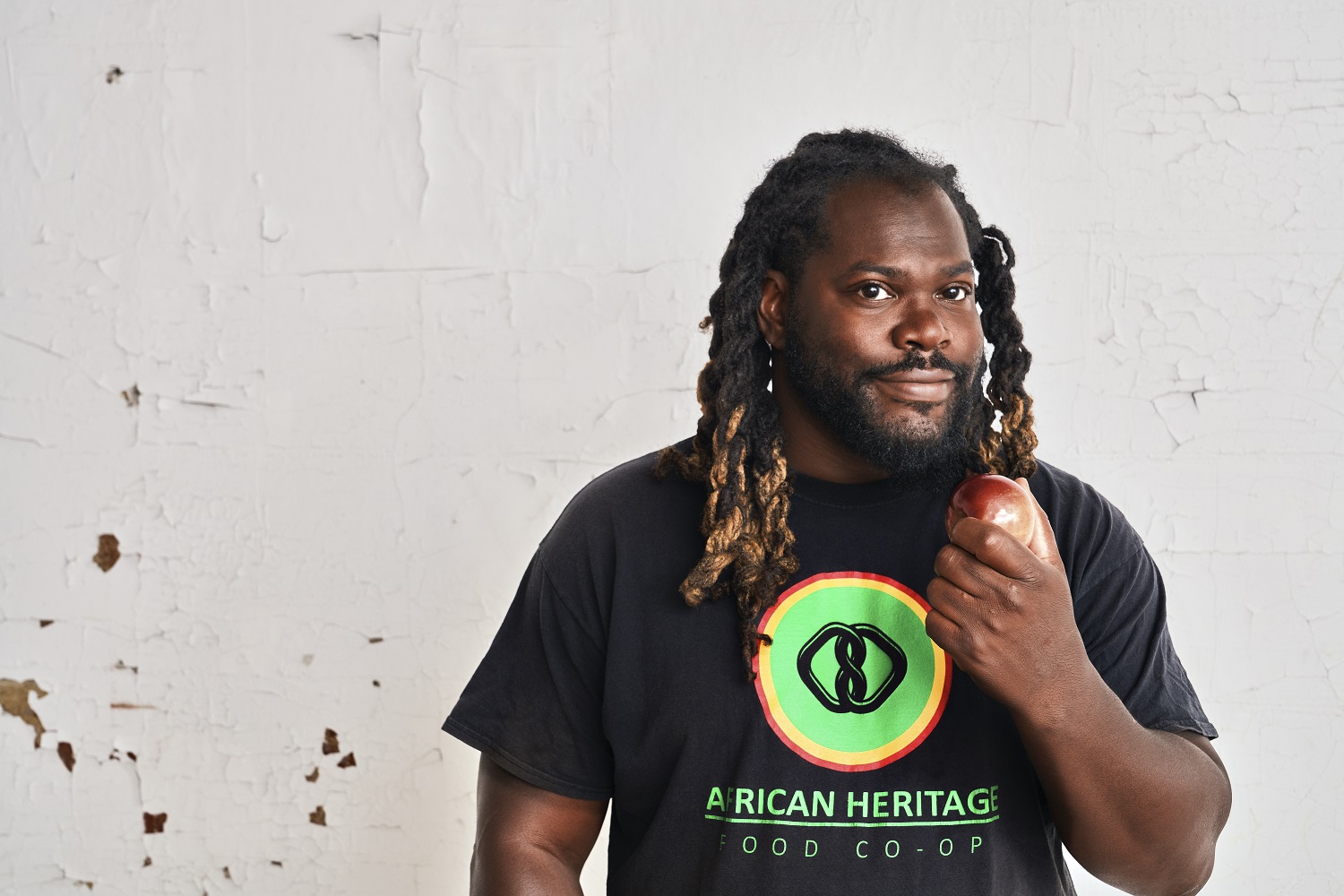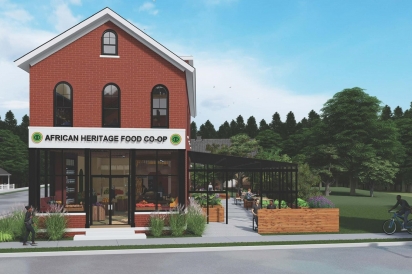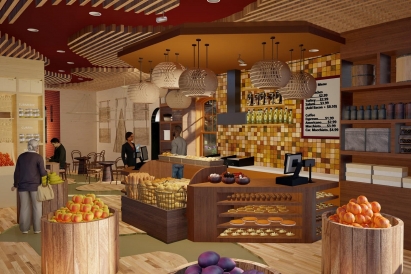African Heritage Food Co-op
“You know how some people look at a piano and they just know what to do?” Alexander J. Wright asks me. “I look at social issues and think like that.”
We’re on the East Side of Buffalo, in a neighborhood that, like many areas of the city, is at once historic and forgotten. In part, we’re talking about how things got this way. Mostly, however, we’re looking to the future, as Wright can’t help but do.
Wright grew up in Buffalo on and off, living in several places on the East Side, including the Buffalo Municipal Housing Authority Commodore Perry Complex. He went away for college, earning a bachelor’s in business management, and then his JD from UB School of Law in 2008.
When he returned to Buffalo after college, he thought, “We’ve had Black leaders from Frederick Douglass to Barack Obama . . . so why does my ’ hood still look like my ’hood?”
He kept pondering this question while working as the executive director of a local nonprofit. There, he witnessed generations—a grandmother, mother and daughter—all utilizing the organization’s food pantry. He went to the board and told them, “‘We’re failing as an organization,’” he recollects. “Because what should be happening is that we’re offering the grandmother services so that the daughter doesn’t need the food pantry, and that the granddaughter can donate to the food pantry.”
“It wasn’t really popular,” Wright sighs. His passion is palpable and infectious—and so is his frustration and anger. “It became clear that my neighborhood still looks this way because the system’s not broken—it’s working exactly the way it’s supposed to. That’s when I started thinking that we needed to go past the nonprofit structures when we talk about eradicating poverty in inner-city areas.”
The African Heritage Food Co-op’s Model
In June 2016, Wright convened the first meeting of the African Heritage Food Co-op (AHFC). That night, 30 like-minded individuals each gave $30 to become member-owners. With that $900, the organization bought as much produce as it could and distributed it, and the AHFC—an idea that had been percolating in Wright’s mind for years—became reality.
Currently, the AHFC employs a three-pronged model consisting of produce box deliveries, farmers’ markets, and brick-and-mortar grocery store locations, all of which are open to anybody. Area subscribers get weekly produce boxes—a half, full or organic—for pickup or delivery, year-round.
At their mobile produce markets, which they do both as stand-alone and at community events, they sell produce to community members, many of whom live in places affected by food apartheid—a term coined by farmer and advocate Karen Washington that Wright is purposeful in using instead of “food desert.” He explains that a desert is naturally occurring, and certain organisms thrive there. “White flight, redlining, other policies—these weren’t phenomena. They were deliberate, intentional, and the purpose was to decimate me and other folks who looked like me.”
In September, they began partnering with KeyBank and Allison DeHonney of Buffalo Go Green to put on a produce market at the Delavan Grider Community Center. The market is set to take place every other Thursday from 4–7pm year-round, moving inside for the winter.
“With the Co-op, not only are you able to deliver fresh produce to the community but you’re giving them a sense of ownership,” says Chiwuike Owunwanne, the corporate responsibility officer and community relations manager of KeyBank for Buffalo, Rochester and eastern Pennsylvania. “It’s easy and energizing to work with folks like Alex who share your vision—and who act on shared beliefs and principles, as opposed to just talking.”
The AHFC also owns and operates a grocery store in Niagara Falls, a purchase made possible in September 2019 by a Housing and Urban Development grant. They plan to open their Buffalo flagship cooperative grocery store, located at 238 Carlton in the Fruit Belt neighborhood, in August 2023. The property, which was purchased and gifted to them by an anonymous donor, was once a grocery store and will be again.
Thus far, the AHFC has worked with local farmers to source their produce. Recently, the Co-op purchased a refrigerated truck, which will expand their sourcing zone and allow them to directly support members of Black Farmers United of New York State.
In conjunction with his work with the AHFC, Wright is also passionate about growing the number of farmers of color locally. To this end, he purchased 22 acres of farmland—known as Blegacy Farms—in Franklinville, where burgeoning farmers can affordably lease parcels of land to grow food, with the AHFC as a guaranteed buyer.
Meeting Community Needs
After the tragic racially motivated mass shooting at the Jefferson Tops in May 2022, the dearth of grocery stores on Buffalo’s East Side was thrust into the local and national spotlight. Wright says that for the AHFC, which had been working to meet this need for years, it made the value of what they were doing undeniable.
Says Gail V. Wells, a Co-op member, community food justice leader and founder of Buffalo Freedom Gardens, “We told powerbrokers that if they wanted to help, ‘Fund the Co-op!’ Because that’s more than just a quick fix.”
The AHFC aims to tackle several issues at once. For one, it combats poverty by employing people from the community and paying them a living wage.
For another, it provides fresh, healthy and affordable food: a particular need among Black Americans, who, according to the CDC, suffer from high blood pressure, diabetes and stroke at much higher rates than White people at every age.
Wright also believes that the Co-op has the power to mitigate price gouging, which is all too common at the corner stores and gas stations where many poor Buffalonians must get their food. “Your doctor tells you that you’re diabetic and you need to start eating better. But you live on Buffalo’s East Side, in a food apartheid. So you have to walk to these places where likely the only produce is a banana that costs a dollar.”
The Appeal of a Cooperative Model
Wright seriously began thinking about cooperative businesses after watching a documentary on the rich and largely unknown history of co-ops in Buffalo. He learned that long before the Lexington Co-op opened in 1971, there was the Citizens Cooperative Society of Buffalo, which began in 1928 with the mission of addressing the social and economic needs of Black Americans locally. The organization, which included a customer-owned grocery store and credit union, continued under various names until shuttering in 1961. Wright’s co-op education also took the form of connecting with Lexington locally, and visiting other food co-ops, particularly those founded by and for people of color, in cities nationwide.
Wright appreciates the co-op’s collective model, which is not about any one person. While he has been the face of the Co-op as it gets up and running, he’s actively working to change this, encouraging AHFC employees and members to speak and stand for what they’re doing.
A Black-owned co-op also adds to the sum of Black-owned businesses. According to a 2022 report by Brookings Metro, in 2019, only 2.3 percent of American businesses were Black-owned, despite Black people comprising 14.2 percent of the population. “When my son goes into a store, he doesn’t see himself,” Wright says. “So how does he know he can do that?”
Additionally, a co-op circumvents some of the barriers Black people encounter when building or advancing their businesses, or even in their careers. “We’re dealing with institutional racism, which creates this glass ceiling that includes Black people not having opportunities for advancement,” Wright says. “But if we own the business, then we’re not worried about the glass ceiling.”
At the AHFC, like other co-ops, member-owners get yearly patronage dividends that are a percentage of the money they spent. Instead of keeping that money, the AHFC is asking members to put it in a Co-op reinvestment fund. The money will ultimately be used to provide seed funding for minority entrepreneurs, who will be chosen in a democratic process. Wright’s goal is to get to 10,000 member-owners, and to have $800,000 in that fund annually.
“When we talk about capitalism, you’re supposed to own as much as you can, at the expense of everyone else,” says Wright. “But the co-op mind-set is: We can win.”
To Wright, it’s imperative that the Co-op stay Black-owned, with the voting rights remaining with the folks who live in the community, which has been a common challenge for other BIPOC-owned co-ops. Wright is clear that he wants allies to patronize the Co-op, be a part of it, and offer resources, but not try to run it.
Looking to the Future
As with many start-ups, funding has been the limiting factor for the AHFC. “It’s difficult to build a plane while you’re flying it, as we’ve had to do so far,” says Wright. “However, that is changing.” This year, the AHFC received $200,000 in funding from the USDA for its stores in Niagara Falls and Buffalo, which they’ll put towards lighting in the parking lot, signage, and more shelving. The Co-op’s Buffalo flagship location is set to receive $3 million from New York State, part of the funds pledged by Governor Kathy Hochul to help East Buffalo.
Currently, 238 Carlton Street is an old brick building next to an empty lot, surrounded by residential streets. The space doesn’t look like much now, but when I close my eyes, I can picture it: the bells on the front door jingling a welcome to customers, the tricked-out golf carts Wright plans to use to transport grocery orders to elders, the scents wafting from the cooking class taking place on the upper level.
It’s a vision Wright has been pushing for years.
“I’m doing this in part to make our elders proud,” he says. “When I walk through the neighborhood, I see people in AHFC hoodies and shirts, showing me that they’re with us. They yell, ‘Hey, Alex! I love what you’re doing. Keep pushing, young man. I can’t wait until that store is open.’ That keeps me going.”






